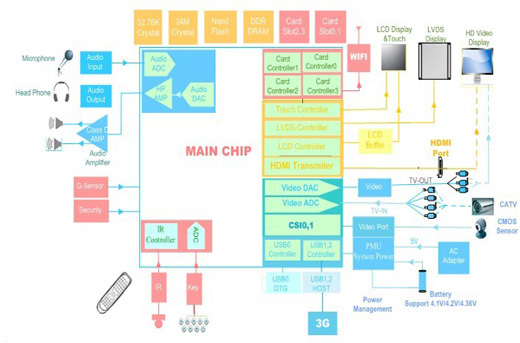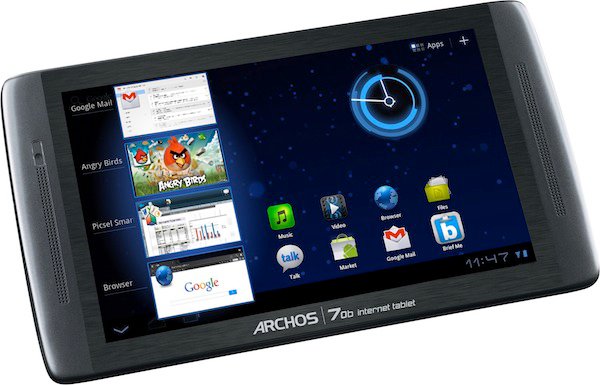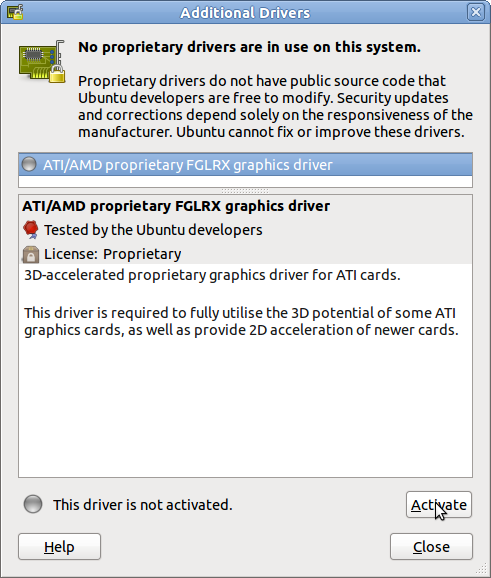AllWinner A10 (part of A1X series) is an ARM Cortex A8 SoC targetting multimedia products such as tablets, HD STB or digital signage. It is currently found in some low cost Android tablets such as Momo9C and will be used in Rhombus Tech’s Raspberry Pi alternative. The processor features an ARM Cortex A8 clocked at 1.5 Ghz with a Mali-400 GPU. It can support 1080p encoding/decoding, provides HDMI, Component, Composite, VGA and LVDS video outputs, USB2.0 ports, a SATA 2.0 port and more… Here are the key features of the Allwinner A10: VPU (Video Processing Unit) HD Video Decoding (Super HD 2160P/3D Film) Support all popular video formats, including VP8, AVS, H. 264 AVC, VC-1, MPEG-1/2/4, … HD Video Encoding (H.264 High Profile) Support encoding in H.264 format DPU (Display Processing Unit) MULTI-CHANNEL HD displays Built-in HDMI YPbPr, CVBS, VGA LCD interfaces: CPU, RGB, LVDS up to Full HD Memory […]
Android Drivers Will Be Included in Linux Kernel 3.3
The Android drivers were no longer accepted in the mainline Linux kernel, starting with Linux kernel 2.6.33, as announced by Greg Kroah-Hartman back in spring 2010. But this is about to change, as it appears that Greg Kroah-Hartman will include the Android drivers into his development branch for the upcoming Linux kernel 3.3, making it boot on Android devices without being patched. The Linux Foundation’s Consumer Electronics workgroup, along with a group at Linaro and various individual developers, is working with Kroah-Hartmann on this project. Tim Bird, chair of the Architecture Group, announced the Android Mainlining Project on the 20th of December with the goal of coordinating work on integrating the Android features. Further information on this project is available on the wiki and developers can also sign up for the project’s mailing list to join the 15 other persons involved in the project.
Linaro 11.12 Release with Kernel 3.1.5
Linaro has just released version 11.12 based on Linux Kernel 3.1.5 and further support for Android 4.0 including graphics hardware acceleration on Snowball and Origen development boards. Here are the highlights of the release: Android Linaro ICS is built with the Linaro toolchain. Linaro ICS is running on all supported boards. DS-5 with Gator is supported in all Linaro Andoid ICS builds. The latest version of libpng (1.5.7) has been integrated in Linaro ICS. An AOSP master build is now available from linaro. ARM® Mali™ Hardware Accelerated Graphics is supported on Origen and Snowball. libjpeg-turbo has been integrated into all Andoid ICS builds. Developer Platform The linux-linaro and lt-panda kernel packages are now automatically generated by the CI build scripts DS-5 with Gator is supported in all Ubuntu LEB builds. XBMC packages, with Gstreamer and OpenGLES support, are now available at the Ubuntu Overlay (supporting only Panda initially) U-Boot-Linaro is […]
Android 4.0 on Archos 70 G8 Tablet
“LeTama” has ported Android ICS to Archos G8 Tablet based on OMAP3630. The video below shows Android 4.0 running on Archos G8 70S. The user interface seems a bit sluggish at times, but this is an alpha version with only 3D/Touchscreen working and more work needs to be done to have a fully functional release.
Graphics Hardware Acceleration for Android 4.0 on Origen and Snowball Development Boards
Last week, Linaro Android team announced that graphics hardware acceleration (2D and 3D) was coming to Android 4.0 for ST Ericsson Nova A9500 Snowball and Samsung Exynos 4210 Origen development boards. They have now release 2 videos to show the progress on the implementation. The first video (around 5 minutes) showcases Samsung Origen development board running Linaro’s build of Android ICS with 2D and 3D demo. The second video (1:21) shows 2D hardware acceleration on ST Ericsson Snowball board. Snowball Android 4.0 daily snapshots and instructions are available at https://android-build.linaro.org/builds/~linaro-android/staging-snowball/ and Origen builds at https://android-build.linaro.org/builds/~linaro-android/staging-origen/ The official December 2011 releases should also come pretty soon are available at http://releases.linaro.org/11.12/android/.
Special Developer Edition (SDE) for Archos G9 Tablets
Back in October, Archos released the GPL source code for Archos G9 Tablets and at the time the Special Developer Edition (SDE) was not released even though it is available for G8 devices. Now the SDE has still not been officially released, but I found a forum post on XDA Developers Forum explaining how the SDE Menu could be enabled by following the instructions below. Root your device with Paul O’Brien’s root here. (it won’t work if the device is not rooted) Unzip the content of gen9_enable_sde.zip to a directory. Launch the script enable_sde. Reboot into recovery mode, you should have the SDE menu now, you can flash your own kernel+initrd the same way it was done on previous generation. One trick: the initramfs should be still named initramfs.cpio.gz, but it should be compressed with lzma with current kernel. Another trick: to get rid of paul’s root as it messes up […]
Archos 70b Internet Tablet: 199 USD Android 3.2 Tablet
Archos announced the 199 USD Archos 70b Internet Tablet (Archos 70b IT) , a 7″ Android 3.2 (Honeycomb) based on a 1.2GHz processor (probably OMAP3630) with 512 MB RAM, and offers a 1024 x 600 capacitive touchscreen, 8GB of storage, HDMI output, and support for Google apps and Android Marketplace. Archos product naming is rather confusing, as they also have an Archos 70b running Android 2.1. So if you go shopping for the new device, make sure it reads Archos 70b Internet Tablet and not just Archos 70b. The Archos 70b IT is an enhanced version of the Archos 70 G8(Generation 8). The CPU (OMAP3630 Cortex-A8 processor) clock rate has been boosted from 1GHz to 1.2GHz, RAM has doubled to 512MB, the resolution resolution has increased to 1024×600 (was 800×480) and the price has dropped to 199 USD from 275 USD. Other features remain the same, as the tablet features […]
Dual Monitor Setup with ATI Graphics Cards in Ubuntu
I’ve recently bought an ATI Radeon HD5450 in order to be able to use multiple displays in Windows XP and Ubuntu 11.04. I’ll explain how to install and configure the ATI drivers in order to use multiple displays and extend the desktop on two monitors. The first thing to do is to install the proprietary ATI drivers and Catalyst Control Center. Click on the icon at the top right of the screen and select “System Settings” in the drop down menu. Then click on “Additional Drivers”, Ubuntu should detect your ATI graphics card automatically and show the following: Click on “Activate” to download and install ATI/AMD proprietary FGLRX graphics driver and Catalyst Control Center (CCC). Alternatively, you could also download the latest linux ATI driver (version 11.12) on ATI website and run ./ati-driver-installer-11-12-x86.x86_64.run After installation, you may have to restart you computer. Once the drivers are installed, if you use […]









